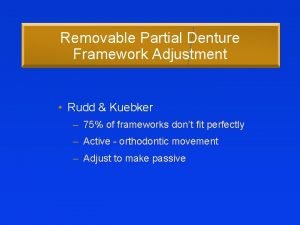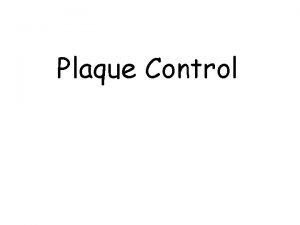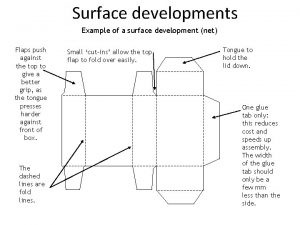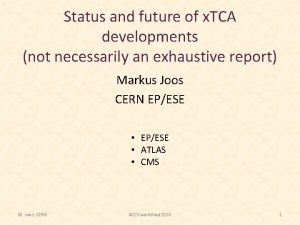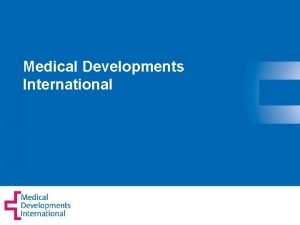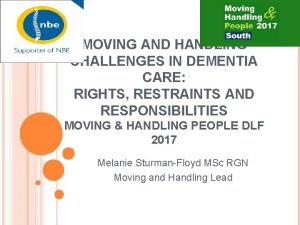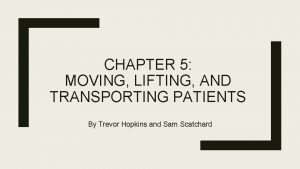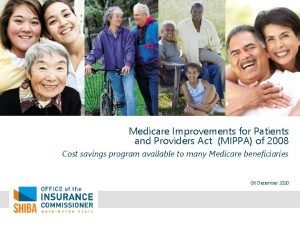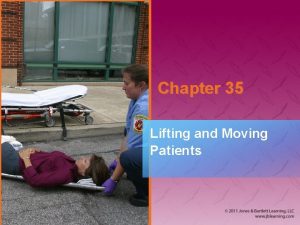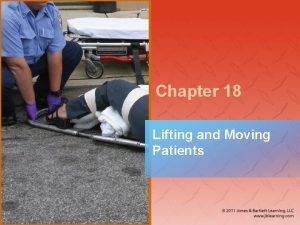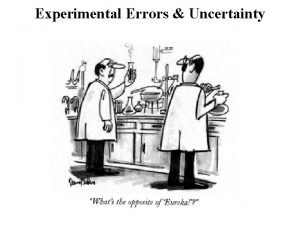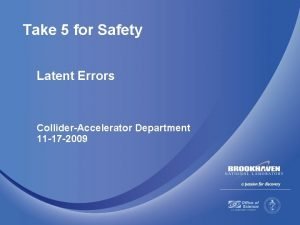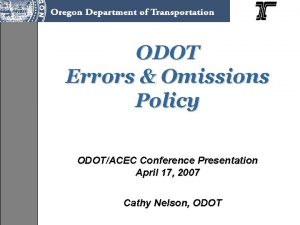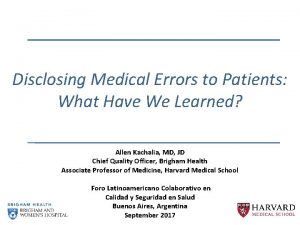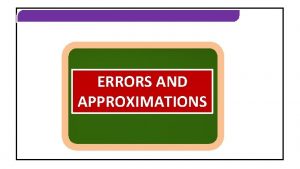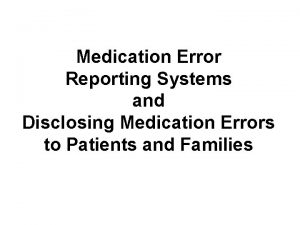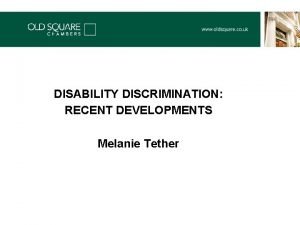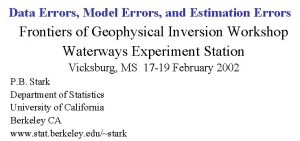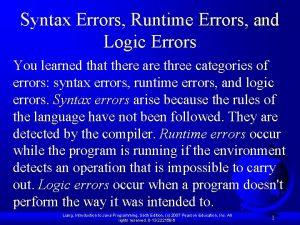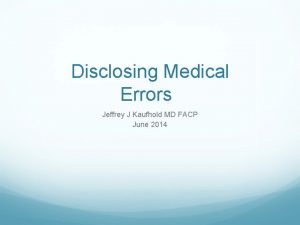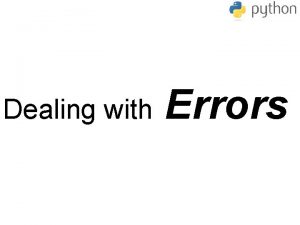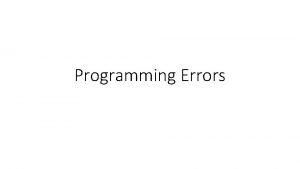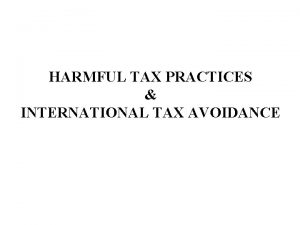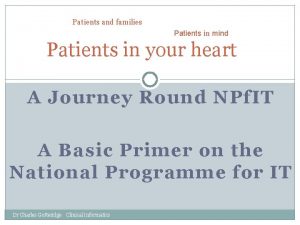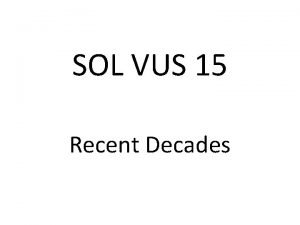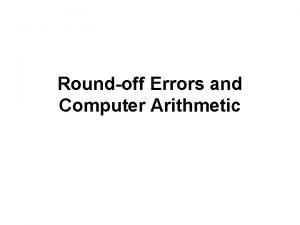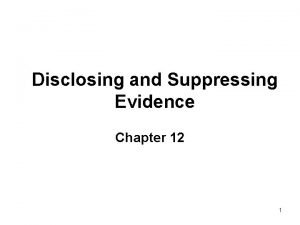Disclosing Harmful Errors to Patients Recent Developments and

























































- Slides: 57

Disclosing Harmful Errors to Patients: Recent Developments and Future Directions Thomas H. Gallagher, MD University of Washington School of Medicine

Accelerating Interest in Disclosure • State laws re disclosure, apology • Growing experimentation with disclosure approaches – Healthcare organizations – Malpractice insurers • New standards-NQF and others • Increased emphasis on transparency in healthcare generally



Disclosure Performance Gap Also Increasingly Evident • Harmful errors often not disclosed • When disclosure does take place, often falls short of meeting patient expectations • Little prospective evidence exits regarding what disclosure strategies are effective • Impact of disclosure on outcomes unclear


Recent Developments • Recent research – Patients’ preferences – Nature of gap • • NQF Safe Practice Legislative Developments Impact of disclosure on outcomes Reports from the field

Relationship of Errors and Adverse Events Medical Errors Adverse Events (complications) Non-preventable AEs Potential AEs Preventable AEs Near Misses

Rationale for Disclosing Errors to Patients • Error disclosure as informed consent – Positive obligation to inform patients of errors • Error disclosure as truth-telling • Regulatory requirements – JCAHO standards, state laws • Disclosure gap – Blendon study: 30% disclosure rate

Ethical Complexities in Error Disclosure • Should I disclose: – Errors with minor/transient harm – Fatal errors – Harmful errors in patients who are hopelessly ill – Other doctors’ errors • Error disclosure as conflict of interest – Is disclosure’s potential for harming healthcare workers morally relevant?

Disclosure Research Agenda • Patient and doctor focus groups on error disclosure – Gallagher TH, et al. Patients’ and Physicians’ Attitudes Regarding the Disclosure of Medical Errors. JAMA. 2003; 289: 1001 -1007. • Surveys of physicians – Gallagher TH, et al. US and Canadian Physicians’ Attitudes and Experiences Regarding Disclosing Errors to Patients. Arch Intern Med 2006; 166: 1605 -1611. – Gallagher TH, et al. Choosing your words carefully: How physicians would disclose harmful medical errors to patients. Arch Intern Med 2006; 166: 1585 -1593. • Standardized patient study with surgeons – Chan D, Gallagher TH, Reznick R, Levinson W. How surgeons disclose medical errors: A study using standardized patients. Surgery, 2005; 138: 851 -8. • Survey of risk managers – Gallagher TH, et al. Risk managers’ attitudes and experiences regarding patient safety and error disclosure: A national survey. Journal of Healthcare Risk Management. 2006; 26: 11 -16 • Focus groups with nurses

Patients’ Attitudes about Errors • Patients conceive of errors broadly • Desire full disclosure of harmful errors – Worry that health care workers might hide errors

Patients’ Preferences for Error Disclosure • Information patients want disclosed – Explicit statement that error occurred – What happened, implications for their health – Why it happened – How will recurrences be prevented • Importance of an apology

Physicians’ Attitudes about Errors • Define errors more narrowly than patients • Agree in principle with full disclosure • Want to be truthful, but experience barriers to disclosure

Barriers to Error Disclosure from Physician Perspective • Concern that disclosure could precipitate a lawsuit • Fear that disclosure could harm patient • Worry that disclosure would be awkward and uncomfortable – Difficulty in admitting to personal failure – No formal training in error disclosure

Choosing Your Words Carefully • Physicians “choose their words carefully” when disclosing errors to patients – Avoid explicit identification of error, discussion of prevention – Assume interested patients will ask clarifying questions – Concern re: legal liability makes apologizing hard

Physician Surveys • Recently completed survey of: – 2, 000 physicians at Washington University/BJC Health. Care, University of Washington, Group Health Cooperative – 2000 Canadian physicians • Topics: Communicating about medical errors with patients, colleagues, and health care institutions • Response rate: 63%

General Attitudes About Disclosure Medicine Statement Surgery % agree, US % agree, Canada “NEAR MISSES should be disclosed to patients. ” 32% 42% 22% 36% “MINOR errors should be disclosed to patients. ” 77% 79% 76% 79% 98% (49% SA) 98% (53% SA) 97% (61% SA) “SERIOUS errors should be disclosed to patients. ”

Disclosure Scenario Overview • Respondents randomized to one of four specialtyspecific disclosure scenarios - Overt error: insulin OD/ retained surgical sponge - Unapparent error: hyperkalemia/bile duct injury during lap chole due to unfamiliarity with new surgical tool • Five questions measured content of disclosure - each question presented actual disclosure language representing no information, a little information, or full disclosure

Scenario 1: Insulin Overdose You have admitted a diabetic patient to the hospital for a COPD exacerbation. You handwrite an order for the patient to receive “ 10 U” of insulin. The “U” in your order looks like a zero. The following morning the patient is given 100 units of insulin, ten times the patient’s normal dose, and is later found unresponsive with a blood sugar level of 35. The patient is resuscitated and transferred to the intensive care unit. You expect the patient to make a full recovery.

How likely would you be to disclose this error to the patient? Response I would definitely not disclose this error I would disclose this error only if asked by the patient I would probably disclose this error I would definitely disclose this error US Medicine Canadian Medicine 0. 5% 0. 6% 3. 0% 1. 3% 31. 8% 22. 8% 64. 8% 75. 3%

What would you most likely say about what happened? US Medicine Canadian Medicine Your blood sugar went too low and you passed out. 1% 1% Your blood sugar went too low because you received more insulin than you needed. 28% 21% 78% Dialogue Your blood sugar went too low because an error happened and you received too much insulin.

How much detail would you most likely give the patient about the error? US Medicine Canadian Medicine I would not volunteer any specific information about the details of the error unless asked by the patient. 11% 8% You received more insulin than you needed. 36% 31% You received 100 units rather than your usual 10 units of insulin. 54% 62% Dialogue

What most closely resembles what you would say about the cause of the error? US Medicine Canadian Medicine I would not volunteer a cause of the error unless the patient asked me. 11% 8% This occurred because of a miscommunication about your insulin order. 55% 42% My handwriting is sometimes difficult to read. I wrote your order for “ 10 U” of insulin and the “U” looked like a “ 0. ” Therefore, you received 100 units of insulin instead of 10. This also slipped by our nurse and pharmacist. 34% 51% Dialogue

What would you most likely say regarding an apology? US Medicine Canadian Medicine I would not volunteer that I was sorry or apologize. 3% 3% I am sorry about what happened. 54% 48% I am so sorry that you were harmed by this error. 43% 49% Dialogue

Scenario 2: Hyperkalemia You start an outpatient with hypertension on a new medicine with a common side effect of increasing the potassium level. The patient’s baseline potassium level is normal (4. 0). You order a repeat potassium blood test to be drawn the next week, but forget to check the lab results. Two weeks after the patient begins this new medicine they start feeling palpitations and go to the emergency room. In the ER the patient experiences an episode of ventricular tachycardia requiring cardioversion. The patient’s potassium level at the time of this event is 7. 5. The patient is hospitalized for four days, and makes a full recovery. The patient returns to your office for a follow-up visit. On reviewing the patient’s chart you see the overlooked labs, which showed the patient’s potassium had risen substantially from 4. 0 to 5. 6. Had you seen this elevated potassium earlier, you would have stopped the new medicine and treated the hyperkalemia, likely avoiding the life-threatening arrhythmia.

How likely would you be to disclose this error to the patient? Response US Medicine Canadian Medicine I would definitely not disclose this error 0. 8% 1. 2% 0. 5% 0. 6% I would disclose this error only if asked by the patient 12. 5% 6. 5% 3. 0% 1. 3% I would probably disclose this error 52. 7% 47. 8% 31. 8% 22. 8% I would definitely disclose this error 34. 1% 44. 4% 64. 8% 75. 3%

What would you most likely say about what happened? US Medicine Canadian Medicine 6% 1% 1% 1% The new medicine we started caused your potassium level to become too high, which led to a dangerous heart rhythm. 55% 57% 28% 21% You had a dangerous heart rhythm because an error happened and we did notice that the new medicine had caused your 40% 41% 78% Dialogue Your potassium level got too high, which led to a dangerous heart rhythm. potassium to become too high.

Scenario 3: Retained Sponge You are seeing a patient 3 weeks post-elective splenectomy for ITP. The splenectomy was technically challenging due to the patient’s obesity, but appeared to be uncomplicated. At this follow-up visit, the patient complains of vague, persistent LUQ pain. You send the patient for an abdominal x-ray, which shows a foreign body consistent with a retained surgical sponge in the patient’s LUQ. You remember that the sponge count was correct at the end of the procedure. However, you also remember that you packed off a small bleeding vessel near the stomach with a sponge, and now do not recall removing this sponge. When you review the postoperative records, you observe that a math error was responsible for a falsely correct sponge count. You believe a re-operation to remove the retained sponge is indicated, and expect the patient will make a full recovery.

How likely would you be to disclose this error to the patient? Response US Surgeons Canadian Surgeons I would definitely not disclose this error 0. 6% 0. 3% 0. 5% 0. 6% I would disclose this error only if asked by the patient 0. 0% 3. 0% 1. 3% I would probably disclose this error 3. 2% 2. 4% 31. 8% 22. 8% 96. 2% 97. 3% 64. 8% 75. 3% I would definitely disclose this error

What would you most likely say about what happened? Dialogue The x-ray showed an abnormality that could be serious. Another operation will be required to investigate and correct this problem. During the surgery, a sponge was inadvertently left in your abdomen. Another operation will be required to remove the sponge. We will have to do another operation because an error happened and a sponge was left in your abdomen. US Surgeons Canadian Surgeons 3% 2% 1% 1% 83% 79% 28% 21% 14% 19% 71% 78%

What would you most likely say regarding an apology? Dialogue I would not volunteer that I was sorry or apologize. I am sorry about what happened. I am so sorry that you were harmed by this error. US Surgeons Canadian Surgeons 19% 13% 3% 3% 72% 69% 54% 48% 9% 18% 43% 49%

Preliminary Survey Conclusions • Physicians support concept of disclosure • Little agreement exists regarding the core content of disclosure • Less information disclosed for errors that would not be apparent to patient • Medical and surgical physicians may approach disclosure differently

Nurses’ Disclosure Attitudes • 9 focus groups at 4 institutions • Support disclosing errors that cause serious harm or require further intervention • Worry that disclosing minor errors would scare patients and family • Eager to participate with MD in disclosure conversations, in part so they won’t be blamed • “Walking on eggshells”

Risk Managers’ Disclosure Attitudes RM (n=1800) Medical errors are one of the most serious problems in health care “Definitely disclose” insulin overdose Use word “error” in disclosing insulin overdose MD 83% agree 65% agree 86% 69% 47% 71%

“Physicians are opposed to disclosing SERIOUS/MINOR errors to patients. ” % Risk Managers SERIOUS errors % Risk Managers MINOR errors Strongly Disagree 5. 6% 1. 9% Disagree 57. 0% 25. 7% Agree 31. 1% 53. 8% Strongly Agree 6. 3% 18. 5% Response



Other recent developments • NQF Safe Practice • Legislative Developments • Impact of disclosure on outcomes – Disclosure and malpractice – Reports from the field

NQF Safe Practices • 30, consensus-based standards • Harmonized with JCAHO, CMS, IHI, Leapfrog, AHRQ • Used in pay-for-performance • Hospital-specific performance on each Safe Practice available on Leapfrog website • Disclosure 1 of 2 new Safe Practices • Final report release 3/2/07

Overview of Disclosure Safe Practice • • Emphasizes transparency as core value Links disclosure with performance improvement Articulates process of disclosure Details institutional disclosure support system – Background education for healthcare workers – Just-in-time coaching – Emotional support for patients, families, healthcare workers

Scope of Proposed Policy • “Serious unanticipated outcomes” – JCAHO Sentinel Events – NQF Serious Reportable Events – Any other unanticipated outcome involving harm requiring substantial additional care or disability >7 days in duration • Disclosure often appropriate for less severe events

Content of Disclosure • Empathic communication of the facts regarding the outcome and its preventability • Expression of regret (all unanticipated outcomes) • Commitment to investigate and prevent future occurrences

“The Facts” • Explicit statement about what happened • Explanation of why event occurred and its preventability, to the extent known • Explanation of the consequences of the unanticipated outcome for the patient’s future health

Additional Content: Feedback of Results �� Results of investigation relevant to unanticipated outcome are communicated to patient, including whether the unanticipated outcome resulted from an error or system failure, in sufficient detail to support informed decision-making by patient.

Apology • Expression of regret appropriate for all unanticipated outcomes • Apology when unanticipated outcome clearly caused by unambiguous error or system failure

Institutional Disclosure Support System • Emotional support for patients, families, healthcare workers • Disclosure education/skill building • Provide disclosure coaching 24/7/365

Impact of Disclosure on Outcomes • Disclosure and malpractice • Reports from the field – COPIC – University of Michigan

What We Know about Relationship Between Disclosure and Litigation • Patients who have sued often cite perception that truth was hidden from them, deficient MD-pt, communication as important motivators • Disclosure reduces intention to sue, promotes more favorable settlements (in vitro) • Disclosure reduces size of jury awards, may make case less attractive to plaintiff attorney • Some institutions have adopted open disclosure policy without deterioration in legal expenses

Important caveats • Vast majority of patients injured by negligent care never sue – Lack of awareness of error may contribute to this low rate – Some recent analysis suggests disclosure may increase litigation • No RCT data exists (or is likely to exist in near future) about impact of disclosure on litigation

Apology Laws • 35 states have adopted apology laws to date • Protection varies widely – Does not mean you can’t be sued if you disclose • 7 states mandate disclosure of some events to patients • Impact of these developments likely to be limited

COPIC • Large Colorado malpractice insurer • Developed “ 3 Rs” Program in 1998 • Program seeks to promote disclosure, early offer following unanticipated outcomes • Exclusions-patient death, attorney involvement, complaint to BME • Patient not asked to sign waiver • Payments not reportable to NPBD

3 Rs Processes • Event reported • Physician and COPIC in accord as to intervention • Doctor tells patient about program, engages in disclosure process, and puts them in touch with 3 Rs administrator • Coaching often required • 3 Rs Administrator supports physician and patient/family and reimburses upon obtaining receipts for out of pocket expenses

3 Rs Program Highlights – 50 Month Financial Results (10/1/00 -12/31/05) Participants 2532 310 for all 50 months; 1713 for 38/50 months Reported Incidents 4674 Cornerstone = Early Incident / Event Reporting 3 Rs Criteria Met 2174 No incident with 3 R criteria met has proceeded to full litigation Closed with no $ Paid 1622 1235 of 2174 closed and 387 about to close with no $ paid, simply satisfactory communication Closed with payment 500 Sent to Claims 52 Spent so far $2, 908, 137 Average paid per incident $5, 680 Dollar range per incident $95 -$30, 000 Operational Costs Total Program Cost $975, 899 $3, 884, 036 259 closed and 241 about to be closed with payment 4 of 52 settled w/o lawyers, indemnity paid, & docs reported; 12 also with 3 R payments (no offset, not reported) About 50/50 spent so far for reimbursable expenses and loss of time Compared to avg. severity in 2003 of $88, 056, and in 2004 of $74, 643, and in 2005 of $77, 936 $30, 000 maximum allowed Two FTE administrators; 1 P/T physician, 1 secretary, managerial consulting All costs (reimbursement $, time loss $, & Administrative $) over 63 months

University of Michigan • In five years since implementing full disclosure program: – Annual litigation costs: • $3 million $1 million – Average time to resolution of claims: • 20. 7 months 9. 5 months – Number of claims and lawsuits • 262 114

Limitations of Existing Data • Generalizability questionable – Involve single institution (academic or Federal) or insurer – Colorado has enacted broad tort reform – COPIC’s culture of early reporting key • Other institutions, insurers adopting similar programs

Future Directions • Ongoing experimentation with disclosure by healthcare organizations, insurers will continue – Will yield useful information on impact of disclosure on outcomes – Additional research sorely needed • Challenges of effective disclosure will become increasingly evident • Additional disclosure standards will be released – Likely to remain voluntary – Link with P-4 -P may prove important
 Recent developments in ict
Recent developments in ict Recent developments in object detection
Recent developments in object detection Classifying household materials
Classifying household materials Physiologic relief rpd
Physiologic relief rpd Periodontium
Periodontium Sahelanthropus tchadensis cultural development brainly
Sahelanthropus tchadensis cultural development brainly Peter rosenwald
Peter rosenwald Political developments in the early republic
Political developments in the early republic Huron creek developments reviews
Huron creek developments reviews Political developments in the early republic
Political developments in the early republic Netflaps
Netflaps Gte milano
Gte milano In the colonial era developments such as the new england
In the colonial era developments such as the new england Target developments
Target developments Two patterns of development
Two patterns of development What industry uses pattern developments?
What industry uses pattern developments? Comtel atca
Comtel atca Democratic developments in england
Democratic developments in england Cplim
Cplim Name
Name Mdi vision
Mdi vision American grassfed association standards
American grassfed association standards How did parliament emerged victorious in medieval england
How did parliament emerged victorious in medieval england Recent trends in ic engine
Recent trends in ic engine Ap synthesis prompt
Ap synthesis prompt Foreign trade
Foreign trade How to skim passages
How to skim passages Trends in project portfolio management
Trends in project portfolio management Recent demographic changes in the uk
Recent demographic changes in the uk Myips powerschool student login
Myips powerschool student login Geotaphonomy
Geotaphonomy Jose has just played a long bruising football game
Jose has just played a long bruising football game A friend emails you the results
A friend emails you the results Recent advances in dental ceramics
Recent advances in dental ceramics News headlines in passive voice
News headlines in passive voice Https://drive.google.com/drive/
Https://drive.google.com/drive/ Udin generate icsi
Udin generate icsi Mis trends
Mis trends Comait
Comait Which is preferred when moving equipment and patients?
Which is preferred when moving equipment and patients? Wendylett sheets 1 carer
Wendylett sheets 1 carer When performing the rapid extrication technique
When performing the rapid extrication technique Semi fowler's position
Semi fowler's position 10 rights of the patient
10 rights of the patient Safe staffing ratios benefiting nurses and patients
Safe staffing ratios benefiting nurses and patients Medicare improvements for patients and providers act
Medicare improvements for patients and providers act You may injure your back if you lift
You may injure your back if you lift Ems lifting techniques
Ems lifting techniques Useful and harmful microbes
Useful and harmful microbes Error of complete reversal of entry example
Error of complete reversal of entry example Receptive and productive errors
Receptive and productive errors By and large what is the cause of intentional rating errors
By and large what is the cause of intentional rating errors Accuracy vs precision graph
Accuracy vs precision graph How to avoid parallax error
How to avoid parallax error Emotional shortcuts
Emotional shortcuts Criminal addictive thinking worksheets
Criminal addictive thinking worksheets Examples of latent errors
Examples of latent errors Errors and omissions definition construction
Errors and omissions definition construction



